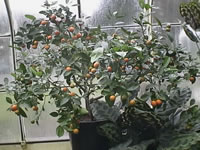Calamondin Orange Trees Pests and Problems
Citrus mitis
I bought a medium size calamondin orange last November from a reputatable garden center in the Pittsburgh area. It was (and still is) covered with ripe oranges. I transplanted it to a 12" pot which gives it some room to grow but is not overly large. I first used a peat based soiless mix and noticed some leaf curl. I then unpotted it and an trying one of the cheaper mixes and added additional sand thinking the growing medium was too rich. I still have a pretty large amount of leaf curl. I am very careful not to over water. I also put the correct amount of osmocote fertilizer in the mix. Do you have any idea what is causing the leaf curl? Also the day temperature is approx 68 nite temp 64 and being winter the humidity is pretty low. This plant is in a west facing window (which is covered with a translucent cover) and light is supplemented by fluorescent lighting. I would appreciate any input as I have wanted a calamondin orange for a very long time and do not want to loose it. Incidentally, I picked one of the oranges and planted the seed and it has sprouted!! Thank you.
Mary Maxwell
 |
Hi Mary, It is not to say that your Calamondon orange (Citrus mitis) doesn't have leaf curl, because leaf curl is typically a fungus which attacks peach, nectarines, and plums. My first impression is that rather than 'leaf curl' you have curling leaves, brought on by transplant shock. Leaf curl is usually evident in the first two weeks after the new leaf buds have opened up. If the curled leaves were mature leaves at the they curled, I don't think that you actually have leaf curl. Have the suspected leaves fallen from the plant, and has the plant deteriorated since you first noticed the problem? If the plant is maintaining its vigor, and hopefully has shown a little improvement, then keep up with a little TLC, and don't worry to much about it. Unless you were excessively rough with the roots when you transplanted it, I think your plant will recover beautifully. Citrus trees like four hours of full sunshine or VERY bright a day to grow and ripen their fruit. They have a shallow root system, so when you are growing them in a container, a wide diameter is far better than a deep one. They prefer light, well-drained soil which is rich in nitrogenous food, such as manure or leaf mold which they need for growth, especially from September to December. In Autumn, fruiting citrus will benefit from plant food rich in Phosphorus and Potassium, which promote flower development and fruit growth. The best growing temperature range would be 68 to 75 degrees F. During the summer months, be sure to provide ample water. Citrus respond to pruning. Keep all the dead branches pruned off, and thin the plant to the three strongest trunks. Since you are growing the plant indoors, be aware that you might need to act as a bee, and do the pollinating yourself with a small, soft bristled paint brush Citrus trees are succeptible to plant scale, mealy bugs, and spider mites, so watch out for them, and treat them appropriately. Having said all of this, I hope that you don't actually have leaf curl. You said that you purchased the plant from a 'reputable' nursery, if your plant does indeed have leaf curl, I would think, and hope that the nursery would do everything they could to fix the problem, like replacing the plant. I certainly would!....Good luck.
Search The Garden Helper: